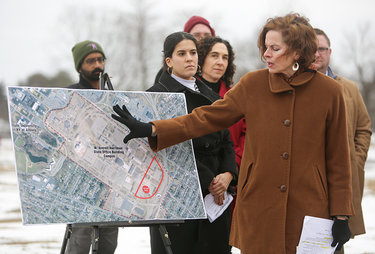‘Missed opportunity’: Fahy, Romero upset mixed use not funded for Wadsworth Lab site
Enterprise file photo — Michael Koff
Senator Patricia Fahy, in January, gestures to a map of the Harriman Campus with Assemblymember Gabriella Romero beside her. The area designated for the $1.7 billion Wadsworth Lab project is circled in red at lower right. Fahy and Romero’s proposal for mixed use on the site is not funded in the state budget.
ALBANY COUNTY — Two Democratic legislators who sponsored bills that would have allowed 7 acres of the 27-acre Wadsworth Laboratory property on the Harriman campus to be developed for mixed use are disappointed their project is not included in the state budget.
The Senate bill introduced by Patricia Fahy also calls for creating a master plan for the redesign of the 330-acre campus at the west end of Albany, which was planned in the 1950s by Governor W. Averell Harriman, for whom it was named.
Gabriella Romero backed a parallel bill in the Assembly.
While Governor Kathy Hochul announced on April 28 that negotiations on a state budget, due on April 1, have ended and she has “reached an agreement” with the legislature, specifics of the spending plan have yet to be detailed.
On May 6, Fahy and Romero issued a joint statement, referencing the $400 million included in the state budget for Albany upgrades, “Despite the transformational $400M we secured that will help revitalize downtown Albany, after years of advocacy, community engagement, coalition-building, and engagement with the Governor’s office, this is a missed opportunity — not just for Albany, but for our broader Capital Region.”
While Fahy and Romero voiced support for the already-approved $1.7 billion Wadsworth Public Health Laboratory on the Harriman campus, they noted the region’s “massive housing affordability crisis and shortage” and said, “That’s why we proposed a vision allowing for housing, commercial or retail space on 7 acres of land that would otherwise remain or be converted into parking spaces, with a comprehensive plan to consider the entire Harriman Campus’ future.”
The campus was built in the Albany Pine Bush next to the Albany Country Club, where the University at Albany’s uptown campus is now. It is bordered by a ring road, which divides it from surrounding neighborhoods; the complex was meant to be accessible to state workers, many of whom lived in the suburbs. The first building, for the Department of Civil Service, opened in 1956.
Building continued apace throughout the 1960s. Then, in the 1970s, under Governor Hugh Carey, many state workers were relocated from suburban to urban settings. This continued through the Mario Cuomo and George Pataki administrations.
At a January press conference promoting her legislation, Fahy described the campus as “some of the worst of a 1960s design … the vast majority of it is already composed of parking lots.”
The point of the proposed legislation, Fahy said then, is to “really think more boldly” rather than thinking of it “as just a one-off” for the labs. “Even the tiniest part of a ring road could free up dozens of acres for this pro-housing agenda that we all know is needed.”
The lab is projected to be finished by 2030 and other development could be built along with it, she said.
Romero echoed Fahy’s thought, saying at the press conference, “This legislation that we’re about to introduce is about creating balance, supporting the lab’s mission while fostering the growth of small business, providing more housing, and making our neighborhoods more walkable and more accessible.”
Romero said she looked forward to “creating a very vibrant, uptown Albany that’s a sustainable place to live and work.”
In February, more than 75 labor leaders, community groups, and elected officials — including Guilderland’s supervisor — signed a letter on Fahy’s letterhead, urging Hochul to support the legislation.
In their May 6 statement, Fahy and Romero said they would keep “working with our coalition” and concluded, “We cannot afford to keep thinking small when the stakes are this high: do we want another 5 decades of a disconnected, sprawling Harriman Campus stuck in the 1960s, or a fully integrated one with space for housing or small businesses that connects seamlessly with our neighborhoods?”


